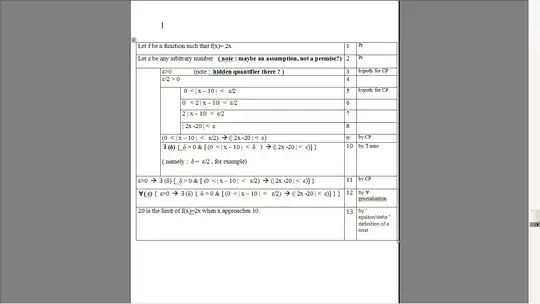- In order to grasp a notion better, it find useful to make use if it in formally rigorous reasonings. This is somewhat artificial and is not practiced by those who are familiar with the concepts, but that is the way my mind works.
Currently, I try to understand the " epsilon / delta" definition of the limit of a function at some value a.
I would like to imbedd the definition in a formal reasoning, applying natural deduction rules.
- I am not talking about he global structure of the proof which is clear to me :
Premise (1) [L is the limit ....] IFF [ for all epsilon.., there is a delta...]
Premise (2) It is the case that [ for all epsilon.., there is a delta...]
Conclusion (3) Therefore [L is the limit ....]
I mean, the logic of the " iff" elimitating is clear enough.
- My question deals with the proof of premise 2 ( in the above argument).
More precisely, my main problem is this : in the proof of premise (2) how to introduce the existential quantifer?
I feel uncomfortable with the examples I have seen so far, when teachers do not introduce explicitly the quantifier " there is some delta such that" and simply say " set delta equal to ..." . What I mean is : is setting a variable at some value the same as introducing an existential quantifier.
To put it another way : in the examples I have seen, the fact that the proof is an existence proof is not made clear enough to me. The existence of the " delta" seems to be postulated rather than proved.
Another problem : if the existence of "epsilon" is not supposed , how could defining "epsilon" in terms of delta could amount to proving the existence of "epsilon"? However, " epsilon" is quantified universalllly, not existentially.
Sure I am missing something here, but can't find out what.
- So, would it be correct to proceed as follows to formalize the example given by the excellent Jim Fowler ( Ohio State Uni.) in his " Calculus Mooculus Week 2 Lecture 14 " video ? ( https://www.youtube.com/watch?v=-9HyfES1VB0&list=PLaLOVNqqD-2H1OJRzQDqYjGjM-XeJCALw&index=28)
The goal is to prove that : "lim ( as x --> 10) of f(x)=2x is 20" .
